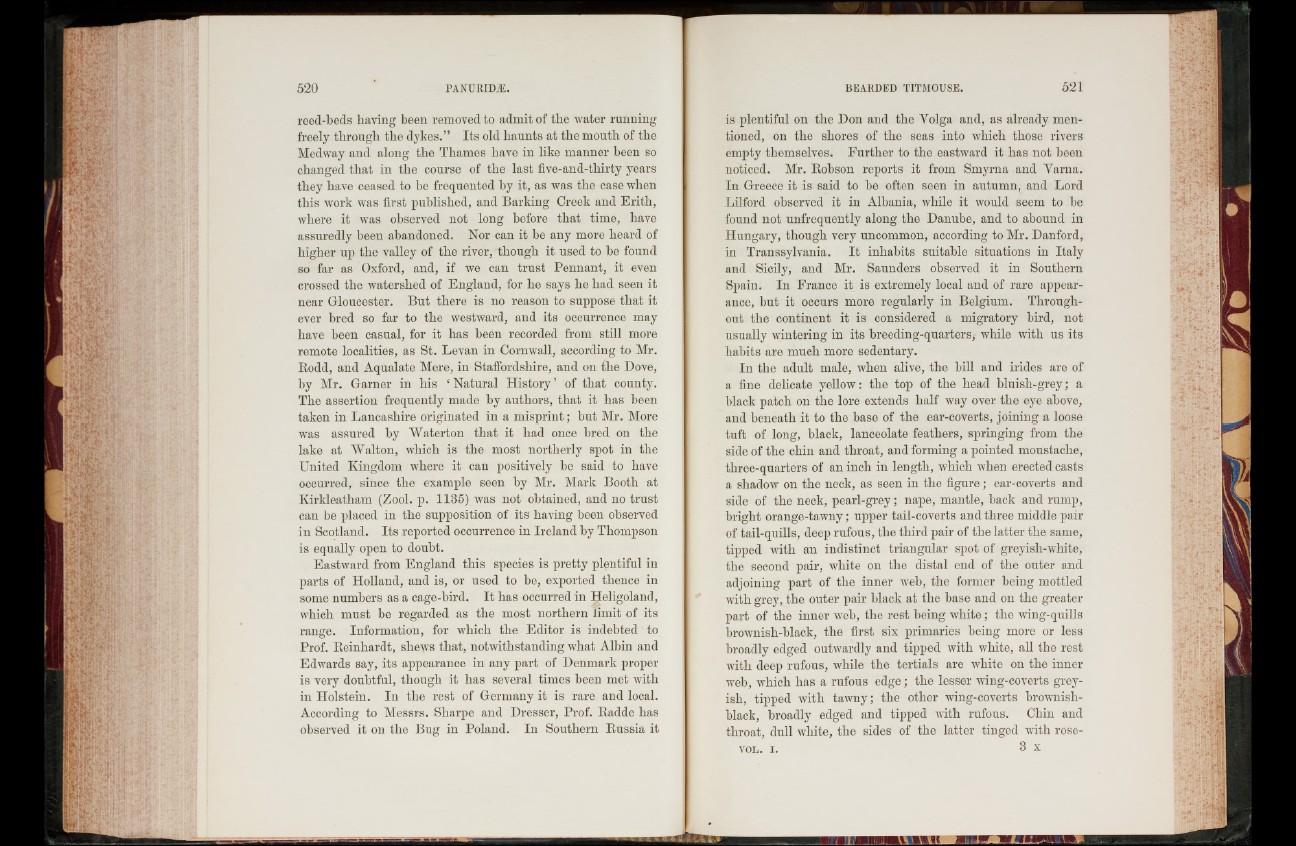
reed-beds having been removed to admit of the water running
freely through the dykes.” Its old haunts at the mouth of the
Medway and along the Thames have in like manner been so
changed that in the course of the last five-and-thirty years
they have ceased to he frequented by it, as was the case when
this work was first published, and Barking Creek and Eritli,
where it was observed not long before that time, have
assuredly been abandoned. Nor can it be any more heard of
higher up the valley of the river, though it used to he found
so far as Oxford, and, if we can trust Pennant, it even
crossed the watershed of England, for he says he had seen it
near Gloucester. But there is no reason to suppose that it
ever bred so far to the westward, and its occurrence may
have been casual, for it has been recorded from still more
remote localities, as St. Levan in Cornwall, according to Mr.
Bodd, and Aqualate Mere, in Staffordshire, and on the Dove,
by Mr. Garner in his ‘ Natural History ’ of that county.
The assertion frequently made by authors, that it has been
taken in Lancashire originated in a misprint; hut Mr. More
was assured by Waterton that it had once bred on the
lake at Walton, which is the most northerly spot in the
United Kingdom where it can positively he said to have
occurred, since the example seen by Mr. Mark Booth at
Kirkleatham (Zool. p. 1135) was not obtained, and no trust
can he placed in the supposition of its having been observed
in Scotland. Its reported occurrence in Ireland by Thompson
is equally open to doubt.
Eastward from England this species is pretty plentiful in
parts of Holland, and is, or used to be, exported thence in
some numbers as a cage-bird. I t has occurred in Heligoland,
which must be regarded as the most northern limit of its
range. Information, for which the Editor is indebted to
Prof. Reinhardt, shews that, notwithstanding what Albin and
Edwards say, its appearance in any part of Denmark proper
is very doubtful, though it has several times been met with
in Holstein. In the rest of Germany it is rare and local.
According to Messrs. Sharpe and Dresser, Prof. Radde has
observed it on the Bug in Poland. In Southern Russia it
is plentiful on the Don and the Volga and, as already mentioned,
on the shores of the seas into which those rivers
empty themselves. Further to the eastward it has not been
noticed. Mr. Robson reports it from Smyrna and Varna.
In Greece it is said to be often seen in autumn, and Lord
Lilford observed it in Albania, while it would seem to he
found not unfrequently along the Danube, and to abound in
Hungary, though very uncommon, according to Mr. Danford,
in Transsylvania. I t inhabits suitable situations in Italy
and Sicily, and Mr. Saunders observed it in Southern
Spain. In France it is extremely local and of rare appearance,
hut it occurs more regularly in Belgium. Throughout
the continent it is considered a migratory bird, not
usually wintering in its breeding-quarters, while with us its
habits are much more sedentary.
In the adult male, when alive, the hill and irides are of
a fine delicate yellow: the top of the head bluish-grey; a
black patch on the lore extends half way over the eye above,
and beneath it to the base of the ear-coverts, joining a loose
tuft of long, black, lanceolate feathers, springing from the
side of the chin and throat, and forming a pointed moustache,
three-quarters of an inch in length, which when erected casts
a shadow on the neck, as seen in the figure; ear-coverts and
side of the neck, pearl-grey; nape, mantle, back and rump,
bright orange-tawny; upper tail-coverts and three middle pair
of tail-quills, deep rufous, the third pair of the latter the same,
tipped with an indistinct triangular spot of greyish-white,
the second pair, white on the distal end of the outer and
adjoining part of the inner weh, the former being mottled
with grey, the outer pair black at the base and on the greater
part of the inner web, the rest being white; the wing-quills
brownish-black, the first six primaries being more or less
broadly edged outwardly and tipped with white, all the rest
with deep rufous, while the tertials are white on the inner
web, which has a rufous edge; the lesser wing-coverts greyish,
tipped with tawny; the other wing-coverts brownisli-
hlack, broadly edged and tipped with rufous. Chin and
throat, dull white, the sides of the latter tinged with rose-
VOL. I. 3 x